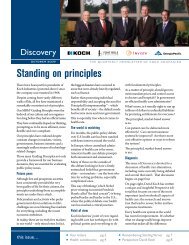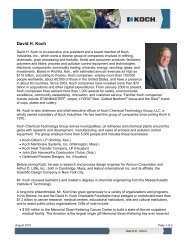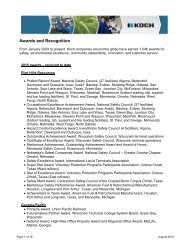human
April 2009 - Koch Industries, Inc.
April 2009 - Koch Industries, Inc.
- No tags were found...
You also want an ePaper? Increase the reach of your titles
YUMPU automatically turns print PDFs into web optimized ePapers that Google loves.
Wet and Wild<br />
Koch efforts to preserve wetlands and promote wildlife<br />
The Koch Wetlands Exhibit<br />
at the Kansas Wetlands<br />
Education Center.<br />
4<br />
Most people think of<br />
Kansas as a dry, windblown<br />
state where the<br />
buffalo roam amid amber waves<br />
of grain.<br />
This is exactly the sort of place<br />
you wouldn’t expect to find shore<br />
birds, such as pelicans or cranes.<br />
But, as a famous song says, “It<br />
ain’t necessarily so.”<br />
Cheyenne Bottoms<br />
Spread out over the middle of<br />
Kansas are 41,000 acres of<br />
wetlands that provide an<br />
important resting place for enormous<br />
flocks of birds as they<br />
migrate across the Great Plains.<br />
This low-lying<br />
area, called<br />
Cheyenne Bottoms,<br />
provides the<br />
richest feeding<br />
grounds along the<br />
Central Flyway,<br />
the primary route<br />
across North<br />
America for<br />
hundreds of<br />
thousands of<br />
migrating birds.<br />
Cheyenne Bottoms also<br />
provides a critical nesting<br />
habitat for a number of threatened<br />
or endangered species,<br />
including whooping cranes, bald<br />
eagles and peregrine falcons.<br />
There are fewer than two<br />
dozen wetland areas of equal<br />
importance in the entire U.S.<br />
Exhibits by Chase Studio<br />
Canada to Cancun<br />
At the peak of the spring<br />
migration season, Cheyenne<br />
Bottoms is home to as many as<br />
250,000 ducks and geese, as well<br />
as white pelicans, sandhill<br />
cranes and numerous songbirds.<br />
During the autumn migration,<br />
more than 600,000 waterfowl<br />
and shorebirds stop to take a<br />
much-needed break during their<br />
trip south.<br />
The area is also home for a<br />
variety of year-round inhabitants,<br />
such as fish, reptiles, amphibians<br />
and many mammals.<br />
In addition to providing<br />
important habitat for a wide<br />
variety of species, Cheyenne<br />
Bottoms acts as a natural water<br />
filtration system. It purifies<br />
storm runoff by trapping silt<br />
and filtering out pollutants.<br />
Time to learn<br />
To help educate visitors<br />
about the significance of this<br />
natural resource, the<br />
Fred C. and Mary R.<br />
Koch Foundation has<br />
donated $500,000 to<br />
underwrite the new<br />
Koch Wetlands Exhibit<br />
at Cheyenne Bottoms.<br />
This 2,000-squarefoot<br />
exhibit hall, which<br />
opened April 24,<br />
includes a variety of<br />
displays explaining the history<br />
and significance of Kansas’<br />
largest ecosystem. These<br />
displays integrate history,<br />
hunting, birding and farming.<br />
Wildlife viewing areas are also<br />
provided.<br />
The exhibit hall is part of the<br />
$4 million Kansas Wetlands<br />
Education Center operated by<br />
Ft. Hays State University. The<br />
architectural plans for the Center<br />
incorporate an arc shape,<br />
echoing the circular encampments<br />
built by Plains Indians<br />
who once inhabited the site.<br />
Numerous state, county and<br />
city governments, educational<br />
groups and non-profit environmental<br />
organizations have<br />
collaborated on this wetlands<br />
project, which has been in<br />
development for several years.<br />
“This is a signature environmental<br />
project for Kansas,” said<br />
Liz Koch, president of the Fred<br />
C. and Mary R. Koch Foundation,<br />
“and one in which we are<br />
proud to play a role.<br />
“As word spreads about the<br />
Center, we think our state will<br />
enjoy economic benefits that<br />
Cheyenne Bottoms was designated a g<br />
result from increased tourism<br />
and use of the Cheyenne<br />
Bottoms area.”<br />
Continuing a tradition<br />
Among Koch company<br />
employees, the Fred C. and<br />
Mary R. Koch Foundation is<br />
perhaps best known for providing<br />
hundreds of college scholarships<br />
to dependents.<br />
But the foundation has also<br />
made millions in contributions<br />
toward environmental projects<br />
across Kansas – a tradition that<br />
reflects the environmental<br />
awareness of its founders, Fred<br />
and Mary Koch.<br />
In addition to sponsoring the<br />
Koch Wetlands Exhibit, the<br />
Foundation has, in recent years,<br />
given $1 million to the Kansas<br />
Nature Conservancy.<br />
That donation, the largest<br />
such gift in the state’s history,<br />
helped establish the Tallgrass<br />
Prairie National Preserve in the<br />
Flint Hills, Kansas’ first and only<br />
National Park Service site.<br />
The foundation also provided<br />
a $300,000 grant for Koch<br />
Habitat Hall at Wichita’s Great<br />
Plains Nature Center, a popular<br />
field trip location for thousands<br />
of Kansas students.<br />
At the grand opening of that<br />
facility, Charles and Liz Koch<br />
watched as a golden eagle did<br />
the honors during a ribboncutting<br />
ceremony.<br />
Flying south<br />
About 400 miles south of<br />
Cheyenne Bottoms (as the eagle<br />
flies), a different sort of environmental<br />
project is unfolding at<br />
Koch’s Matador Ranch.<br />
Incorporated in 1882, the<br />
Matador Land and Cattle<br />
Company was owned by a<br />
group of Scottish investors for<br />
almost 70 years.<br />
Fred Koch bought prime<br />
portions of this Texas ranch





